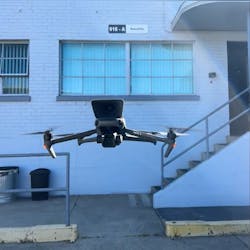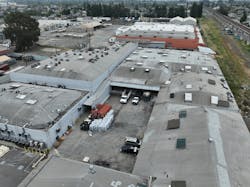How to harness the power of drones
At a time of rapid technological advancement, drones have emerged as pivotal assets in the security industry, transforming traditional methods and introducing a new layer of effectiveness and efficiency. As security challenges evolve, integrating Unmanned Aircraft Systems (UASs), or drones, into security protocols offers unprecedented surveillance, monitoring, and operational safety advantages in myriad vertical markets, including cannabis grow facilities.
Expanding Reach and Enhancing Visibility
Drones significantly enhance how surveillance is conducted over large and or specific areas. Traditional security measures are often limited by physical barriers and the sheer scale of territories like industrial complexes, large estates, and border areas. Drones eliminate these limitations, offering a bird's-eye view that ensures comprehensive coverage without the constraints of ground-based obstacles. Equipped with high-resolution cameras and thermal imaging capabilities, drones can deliver real-time video feed to security personnel, enabling them to monitor expansive areas with greater precision and fewer resources.
Keeping Personnel Out of Harm's Way
One of the most significant advantages of employing remotely piloted drones is their ability to keep security personnel out of immediate danger. These drones can safely enter potentially hazardous situations—whether it's a hostile environment with criminal activity, suspicious behavior, or a natural disaster area —without risking human lives. This capability is crucial for maintaining the safety of security teams and ensuring that they can relay information to law enforcement or emergency personnel based on the live feedback and data collected by drones.
Increasing Response Times and Efficiency
Another standout benefit of using drones in security applications is their ability to improve response times drastically. In situations where every second counts, such as potential intrusions or emergency incidents, drones can be deployed instantly to assess the situation. This rapid deployment capability allows security teams to manage situations proactively, providing live updates to law enforcement that are critical in shaping response strategies without putting personnel in immediate danger.
Cost-Effective Surveillance Solutions
Incorporating drones into security strategies also presents a cost-effective solution for many organizations. Compared to the expenses associated with manned patrols or the installation of extensive fixed surveillance systems, drones offer a dynamic and adaptable alternative. They can perform routine patrols autonomously and be redirected at a fraction of the cost, all while delivering superior data and imagery that can be crucial for real-time security and forensic analysis.
Integrating with Existing Security Frameworks and Added Benefits
The true potential of drones is best realized when they are integrated into a broader security framework, which TLBC is pioneering today. By coupling drone technology with other security systems like ground-based sensors and AI-driven analytical tools, organizations can create a comprehensive security solution that leverages the strengths of each component. This integrated approach improves overall security and aids in strategically allocating human resources, focusing on intervention and decision-making rather than routine monitoring tasks.
For example, TLBC is conducting drone patrols today to increase situational awareness in Oakland, California. One of the biggest benefits for the guards on site is increased visibility of the property. Viewpoints from drones, especially when integrated into existing video surveillance footage, drastically increase the guard's ability to patrol a site location.
The true potential of drones is best realized when they are integrated into a broader security framework, which TLBC is pioneering today.
Workforce Development
As the security landscape changes with the evolution of technology, the need for guards will likely decrease over time. In today’s landscape, guards do not always deter crime as we may hope. We can watch countless videos of crimes in progress happening in front of security guards. Liability, training, changing criminal landscape, prosecution of crimes, resources, and other factors affect this growing trend. Increasingly, guards are relied upon not to deter crime or even stop crime but to alert first responders and get them on site as quickly as possible. This can be done (and to some degree being done) today with drones.
TLBC is actively training armed and unarmed guards to become Part 107 drone pilots. By allowing guards to use new and developing technology, we can tap into their vast knowledge of the traditional security guard space while enhancing their situational awareness and creating educational and professional development opportunities. This is particularly interesting given how quickly technology in the security space evolves and, in some cases, removes guards from the equation altogether.
Navigating Regulatory Concerns
The deployment of drones in security applications requires adherence to strict regulatory standards. As drone usage becomes more widespread, organizations must comply with local and international regulations concerning UAS operations. Utilizing solutions like Aloft for maintaining airspace authorization and communication with the Federal Aviation Administration (FAA) is essential. Aloft allows operators to manage their drones with updated information on airspace conditions, ensuring compliance and operational safety in congested airspace.
Conclusion
As the security landscape continues to evolve, drones (UAS) are set to play an increasingly integral role in security operations. By leveraging the capabilities of UAS technology, security operations can become more proactive, efficient, and adaptable to the challenges of the modern world. Whether enhancing perimeter security, assisting law enforcement efforts, or integrating into existing security systems, drones offer a promising enhancement to traditional security measures, marking a new era in surveillance technology.
Chris Eggers is the CEO and founder of California-based Cannabis Compliant Security Solutions (CCSS), a consulting firm founded in 2021 with a mission and vision to re-define, disrupt, and significantly improve cannabis security and risk management for all licensed cannabis operators, including social equity operators and applicants.
About the Author

Chris Eggers
Chris Eggers is the CEO and founder of California-based Cannabis Compliant Security Solutions (CCSS), a consulting firm founded in 2021 with a mission and vision to re-define, disrupt, and significantly improve cannabis security and risk management for all licensed cannabis operators, including social equity operators and applicants. Learn more about CCSS at https://ccsecuritysolutions.com.

